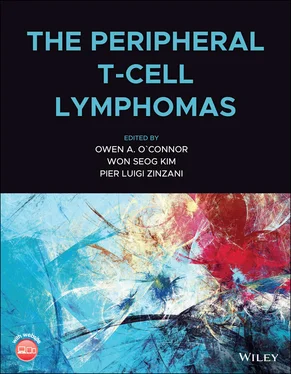1 ...6 7 8 10 11 12 ...40 15 15 Boutista, J.L., Lio, C.W.J., Lathrop, S.K. et al. (2009). Intraclonal competition limits the fate determination of regulatory T cells in the thymus. Nat Immunol 10: 610–617.
16 16 Szabo, P.A., Levitin, H.M., Miron, M. et al. (2019). Single‐cell transcriptomics of human T cells reveals tissue and activation signatures in health and disease. Nat Commun 10 (1): 4706.
17 17 Miyao, T., Floess, S., Setoguchi, R. et al. (2020). Plasticity of Foxp3+ T cells reflects promiscuous Foxp3 expression in conventional T cells but not reprogramming of regulatory T cells. Immunity 36 (2): 262–275.
18 18 Trüb, M., Barr, T.A., Morrison, V.L. et al. (2017). Heterogeneity of phenotype and function reflects the multistage development of T follicular helper cells. Front Immunol 8: 489.
19 19 Marchingo, J.M., Sinclair, L.V., Howden, A.J.M., and Cantrell, D.A. (2020). Quantitative analysis of how Myc controls T cell proteomes and metabolic pathways during T cell activation. eLife 9: e53725.
20 20 Manso, R., Bellas, C., Martín‐Acosta, P. et al. (2016). C‐MYC is related to GATA3 expression and associated with poor prognosis in nodal peripheral t‐cell lymphomas. Haematologica 101: e336–e338.
21 21 Levayer, R., Hauert, B., and Moreno, E. (2015). Cell mixing induced by myc is required for competitive tissue invasion and destruction. Nature 524: 476–480.
2 Mechanisms of T‐cell Lymphomagenesis
François Lemonnier1,2,3, Philippe Gaulard2,3,4 and Laurence de Leval5
1 Unité hémopathies Lymphoïdes, Hôpitaux Universitaires Henri Mondor, Créteil, France
2 Assistance Publique des Hôpitaux de Paris, Paris, France
3 Institut Mondor de Recherche Biomédicale, INSERMU955, Université Paris Est Créteil, Créteil, France
4 Département de Pathologie, Hôpitaux Universitaires Henri Mondor, Créteil, France
5 Institut de Pathologie, Centre Hospitalier Universitaire Vaudois et Université de Lausanne, Lausanne, Switzerland
The peripheral T‐cell lymphomas (PTCL) are characterized by the accumulation of mutations in genes that govern multiple epigenetic pathways, with some entities like PTCL‐follicular helper T cell and angioimmunoblastic T‐cell lymphomas (AITL), representing the subtypes most enriched for these genetic events.
Mutation‐induced activation of signaling pathways that play a key role in normal T and natural‐killer (NK) cell physiology, like the Janus kinase/signal transducers and activators of transcription pathway or T‐cell receptor signaling, are highly recurrent and common to many entities.
Extranodal NK/T‐cell lymphoma and adult T‐cell leukemia/lymphoma represent two remarkable models lymphomas induced by viruses with superimposed genetic lesions.
The tumor microenvironment, and the nature of its cellular milieu, plays an important role in PTLC lymphomagenesis, especially in AITL.
Peripheral T‐cell lymphomas (PTCLs) collectively include neoplasms of mature (i.e. post‐thymic) T or natural killer (NK) cells. As in other cancers, the neoplastic transformation encompasses a multistep process altering pivotal cellular pathways to allow for the survival and expansion of the neoplastic clone, and the recruitment of a favorable microenvironment. Interestingly, neoplastic T or NK cells retain some features related to their cellular differentiation, which affects the clinical, pathological, and biological presentation of the diseases, as well as their outcomes. In this chapter, we review the main types of genetic alterations found in PTCL, discuss the role and importance of the tumor microenvironment and the underlying conditions favoring T‐cell transformation, and the relevance of cell‐of‐origin to T‐cell lymphoma genesis and biology.
Oncogenic Events in the Transformation of T or Natural Killer Cells
Genetic Lesions
Tumor transformation is driven by genetic events that modify a biological function. Among structural variants first described is the chromosomal translocation involving the ALK oncogene at 5q35 locus. In this translocation, ALK is fused to various partners, most often NPM (nucleophosmin), resulting in abnormal expression of ALK hybrid proteins in anaplastic large‐cell lymphomas (ALCL) [1]. Thus, anaplastic lymphoma kinase positive (ALK+) ALCL was the first genetically defined T‐cell lymphoma entity. With the development of high‐throughput sequencing methods, especially RNA sequencing, many other chromosomal translocations or gene fusions have subsequently been described in PTCL, deregulating various oncogenes such as DUSP22 [2] , TP63 [2] , VAV1 [3] , CD28‐ICOS , or CD28‐CTLA4 [4, 5]. Besides these translocations and fusions, copy number variants (CNV) are frequent in PTCL. Some CNV are unique to some subtypes of the disease, including for example, gains in chromosomes 5 and 21 in IDH2 R172‐mutated angioimmunoblastic T‐cell lymphomas (AITL) [6]. In addition, complex genetic changes appear frequent in GATA3‐positive PTCL not otherwise specified (PTCL‐NOS), which have a high frequency of alterations in PTEN‐PI3K and CDKN2A‐TP53 pathways, highlighting the implication of P53 loss in the development of genomic instability [6]. More rarely, chromothripsis, an episode of catastrophic chromosomal rearrangement [7], has been described [8], but no dedicated study has been conducted to evaluate its incidence.
Next‐generation targeted, whole‐exome or whole‐genome sequencing studies have reported single‐nucleotide variants or indel mutations in coding sequences, leading to the loss of function of a tumor suppressor gene, impacting epigenetic regulation or cell‐cycle control, or a gain of function of a proto‐oncogene, resulting for example in increased signaling, in most PTCL entities. Splice site mutations in tumor suppressor genes like TET2 or DNMT3A frequently occur and result in loss of function.
Coding sequences represent only a small fraction of the genome, and genetic events altering noncoding regions have been identified. Although the functional consequences of many of them are largely unknown, some events altering the noncoding region may have important biological consequences. For example, structural variants altering 3′ untranslated region (UTR) of PDL1 resulting in PDL1 overexpression and immune escape, have been described in adult T‐cell leukemia/lymphoma (ATLL) [9] or in extranodal NK/T‐cell lymphoma (ENKTL), nasal‐type [10], two diseases related to viral infections. Dysregulation of non‐coding RNA is also observed; some microRNA [11] or small nucleolar RNA [12] signatures are entity specific and could aid in diagnosis, while some may play a role in oncogenesis. However, the role of the anomalies affecting the non‐coding genome is largely unexplored.
Beyond the genetic and epigenetic anomalies, viruses can directly or indirectly play a role in the oncogenic transformation. Two viruses with oncogenic properties, human T‐cell lymphotropic virus type 1 (HTLV1) and Epstein–Barr virus (EBV) are causally linked to a spectrum of lymphoproliferations derived from T or NK cells (see below).
Deregulated Pathways in Peripheral T‐cell Lymphoma Oncogenesis ( Figure 2.1, Table 2.1)
Epigenetic Regulation
Genomic studies have highlighted epigenetic regulators as the category of genes most frequently altered in PTCL. Indeed, integrated molecular analyses of Sézary syndrome [13], ATLL [10], or PTCL of T follicular helper (Tfh) origin [14, 15] has revealed anomalies in epigenetic regulators in up to 90% of the cases. For example, mutations in TET2 [14–16] , DNMT3A [17] and IDH2 [18] are observed in 80%, 30%, and 20–30% of PTCL derived from Tfh cells, respectively. These three mutations induce changes in cytosine methylation and hydroxymethylation levels. TET2 is an α‐ketoglutarate‐dependent dioxygenase involved in the successive oxidation of 5‐methylcytosine to 5‐hydroxymethylcytosine (5hmC) to 5‐formylmethylcytosine and 5‐carboxymethylcytosine, resulting in the demethylation of 5‐cytosine, through the thymine DNA glycosylase‐mediated base excision system [19]. Although TET2 was initially thought to play an important role in active cytosine demethylation, evidence is emerging that TET2 is pivotal in the generation of 5hmC, which is critical for enhancer functions [20]. DNMT3A is a de novo DNA methyltransferase, supporting the transformation of 5‐cytosine to 5‐methylcytosine. Mutations in TET2 and DNMT3A are loss of function and distributed along the coding sequences of the genes, with few hotspots, like the dominant‐negative DNMT3A R882Xmutant [20]. IDH2 mutations confer a neoenzymatic activity producing D‐2 hydroxyglutarate. This metabolite, often referred to as an oncometabolite, is physiologically present at very low levels, and inhibits numerous α‐ketoglutarate‐dependent dioxygenases, including TET proteins or histone demethylases [21]. While IDH1/2 and TET2 mutations in acute myeloid leukemia are mutually exclusive, both resulting in a specific methylation profile, they frequently coexist in AITL.
Читать дальше












